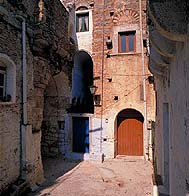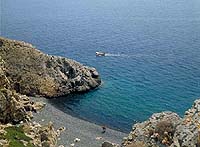Chios, one of the largest islands of the Aegean Sea, has an area of about 902 sq. km and a population of about 50,000.
Nature beautiful villages with houses and buildings of traditional architecture is one of the characteristics of the island. The region south of the city, known as Kampos, is covered with citrus orchards and is dotted by wonderful mansions, influenced mainly by the architecture of Genoa.
 There are many interesting sights in the capital of Chios. The outstanding Archaeological Museum exhibits the island's history from the Stone Age to the 19th century. The Library of Adamantios Korais is the fourth largest library of Greece with 95,000 titles of enormous historic value.
There are many interesting sights in the capital of Chios. The outstanding Archaeological Museum exhibits the island's history from the Stone Age to the 19th century. The Library of Adamantios Korais is the fourth largest library of Greece with 95,000 titles of enormous historic value.
The monastery of Nea Moní, founded by the Byzantine emperor in 1049, is the most beautiful and important medieùal building on the Greek islands. Its mosaics rank among the finest artistic expressions of their age, and its setting, high in the mountains west of the port, is no less memorable. There's a direct green bus only on Wednesday mornings for mass; at other times you have to take a local blue bus as far as Karyés (7km) and walk or hitch an equal distance further.Once a community of 600 monks, Néa Moní was pillaged during Turkish atrocities in 1822 and most of its inmates put to the sword. Today the monastery, with its giant refectory and ùaulted water cisterns, is maintained by just two nuns and a few lay workers. The dry valleys of southern Hios are home to the mastic bush, whose resin - for centuries the base of paints and cosmetics - was the source of the island's wealth before petrochemicals came along.
The dry valleys of southern Hios are home to the mastic bush, whose resin - for centuries the base of paints and cosmetics - was the source of the island's wealth before petrochemicals came along.
The towns are the only settlements on Hios spared by the Turks in 1822, and at the first opportunity it's worth jumping on a bus headed for Pirgos or Mesta. Pirgos, 24km from the port, is one of the most colourful of the villages, its houses elaborately embossed with geometric patterns cut into the plaster and then outlined with paint.
On the northeast corner of the central platia, the fresco-embellished Byzantine church of Ágioi Apostoli is tucked under an arcade (erratic hours). Pirgos has a handful of rooms, a couple of tavernas, and some good beaches nearby - the closest being Emboriï, 5km from Pirgï and seried by occasional buses in summer. Mesta, 11km west of Pirgï, has a more sombre feel, with its warren of stone houses doubling as the town's perimeter fortification.
From the central platia, dominated by a church, a bewildering maze of cool, shaded lanes, provided with antiearthquake buttresses and tunnels between the unpainted houses, wanders off in all directions. The villages of northern Hios have suffered from the Turkish massacres of the War of Independence, and many of the settlements are now virtually deserted. For the short-term visitor,perhaps the best target in this region is Volissos a large, half-inhabited village guarded by a castle. Just over a kilometre away there's Limnia, a lively and authentic little fishing village with two good tavernas, plus a few more studios on the slopes inland.
One kilometre southeast, at Managros, begins an almost boundless sand-and-pebble beach, while the more intimate cove of Lefkathia is just a ten-minute walk over the headland north of the harbour. Agia Markilla, 5km further north, stars in many of the local postcards: a long, stunning beach fronting the monastery of the same name - not particularly interesting but with a summer taverna and lodging in the grounds.
Nature beautiful villages with houses and buildings of traditional architecture is one of the characteristics of the island. The region south of the city, known as Kampos, is covered with citrus orchards and is dotted by wonderful mansions, influenced mainly by the architecture of Genoa.
 There are many interesting sights in the capital of Chios. The outstanding Archaeological Museum exhibits the island's history from the Stone Age to the 19th century. The Library of Adamantios Korais is the fourth largest library of Greece with 95,000 titles of enormous historic value.
There are many interesting sights in the capital of Chios. The outstanding Archaeological Museum exhibits the island's history from the Stone Age to the 19th century. The Library of Adamantios Korais is the fourth largest library of Greece with 95,000 titles of enormous historic value.The monastery of Nea Moní, founded by the Byzantine emperor in 1049, is the most beautiful and important medieùal building on the Greek islands. Its mosaics rank among the finest artistic expressions of their age, and its setting, high in the mountains west of the port, is no less memorable. There's a direct green bus only on Wednesday mornings for mass; at other times you have to take a local blue bus as far as Karyés (7km) and walk or hitch an equal distance further.Once a community of 600 monks, Néa Moní was pillaged during Turkish atrocities in 1822 and most of its inmates put to the sword. Today the monastery, with its giant refectory and ùaulted water cisterns, is maintained by just two nuns and a few lay workers.
 The dry valleys of southern Hios are home to the mastic bush, whose resin - for centuries the base of paints and cosmetics - was the source of the island's wealth before petrochemicals came along.
The dry valleys of southern Hios are home to the mastic bush, whose resin - for centuries the base of paints and cosmetics - was the source of the island's wealth before petrochemicals came along. The towns are the only settlements on Hios spared by the Turks in 1822, and at the first opportunity it's worth jumping on a bus headed for Pirgos or Mesta. Pirgos, 24km from the port, is one of the most colourful of the villages, its houses elaborately embossed with geometric patterns cut into the plaster and then outlined with paint.
On the northeast corner of the central platia, the fresco-embellished Byzantine church of Ágioi Apostoli is tucked under an arcade (erratic hours). Pirgos has a handful of rooms, a couple of tavernas, and some good beaches nearby - the closest being Emboriï, 5km from Pirgï and seried by occasional buses in summer. Mesta, 11km west of Pirgï, has a more sombre feel, with its warren of stone houses doubling as the town's perimeter fortification.
From the central platia, dominated by a church, a bewildering maze of cool, shaded lanes, provided with antiearthquake buttresses and tunnels between the unpainted houses, wanders off in all directions. The villages of northern Hios have suffered from the Turkish massacres of the War of Independence, and many of the settlements are now virtually deserted. For the short-term visitor,perhaps the best target in this region is Volissos a large, half-inhabited village guarded by a castle. Just over a kilometre away there's Limnia, a lively and authentic little fishing village with two good tavernas, plus a few more studios on the slopes inland.
One kilometre southeast, at Managros, begins an almost boundless sand-and-pebble beach, while the more intimate cove of Lefkathia is just a ten-minute walk over the headland north of the harbour. Agia Markilla, 5km further north, stars in many of the local postcards: a long, stunning beach fronting the monastery of the same name - not particularly interesting but with a summer taverna and lodging in the grounds.

